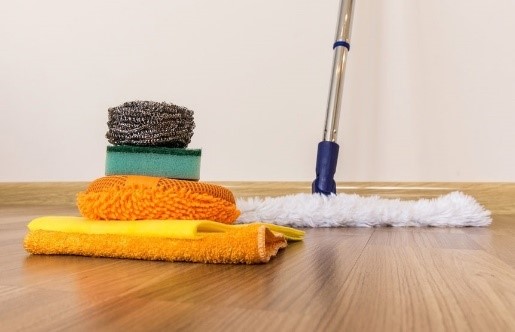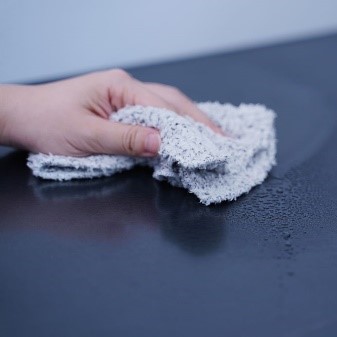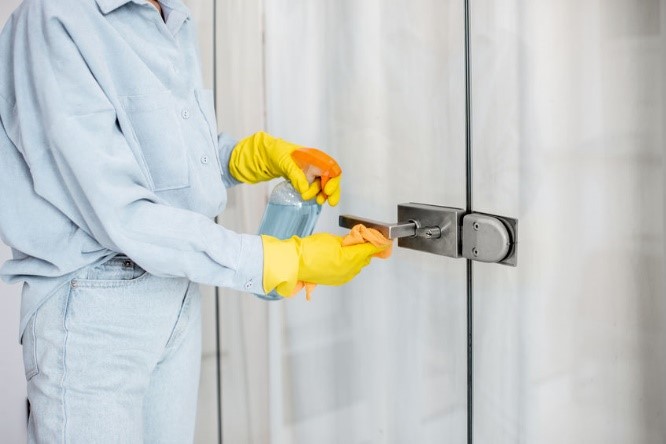Differences Between Cleaning, Sanitizing, & Disinfecting

Cleaning, sanitizing, and disinfecting are often used interchangeably when we talk about removing and killing germs and bacteria. While they have some similarities between them, they each have different purposes.
Cleaning
Cleaning is the most general and basic of the three. It removes germs, dirt, dust, spills, etc. from surfaces and objects. This is usually done through a process of washing and rinsing, such as wiping down a table with a soapy rag, dusting shelves, or mopping the floor. It’s important to note that while cleaning physically removes germs, it does not kill them. However, by reducing the number of germs on a surface, cleaning can help stop or slow the spread of diseases and viruses.
Cleaning is typically something done on a regular basis in your home or
work environment to keep things tidy and get rid of dirt or messes. A regular
cleaning schedule can help lower the spread of harmful germs and bacteria.
Sanitizing Sanitizing reduces the number of bacteria and germs that exist on a surface or object to a safe level based on public health guidelines. Like cleaning, this only removes but does not kill germs. Cleaning can be one of the methods used to disinfect a surface or object, though. The important part here, and what makes sanitizing different from just cleaning, is that the number of germs reaches a low enough number to be deemed safe. It’s a good idea to regularly sanitize surfaces such as doorknobs, children’s toys, and light switches.
Sanitizing reduces the number of bacteria and germs that exist on a surface or object to a safe level based on public health guidelines. Like cleaning, this only removes but does not kill germs. Cleaning can be one of the methods used to disinfect a surface or object, though. The important part here, and what makes sanitizing different from just cleaning, is that the number of germs reaches a low enough number to be deemed safe. It’s a good idea to regularly sanitize surfaces such as doorknobs, children’s toys, and light switches.
Sanitizing is especially important in environments like kitchens and food prep areas. In these environments, dishes, tables, and countertops are often treated with some type of sanitizer in addition to, or instead of, plain soap.
Disinfecting
Out of the three, disinfecting is the only one to reduce the spread of viruses and diseases by actually killing the germs that live on surfaces and objects. This is usually done by using chemicals proven to kill germs. However,  disinfecting does not guarantee a clean surface. After disinfecting, the surface or object can still have dirt or other impurities on it. Disinfecting is best done after cleaning to ensure that germs and bacteria left behind are being killed. This is especially important in environments or situations where there’s a high risk of illness being spread.
disinfecting does not guarantee a clean surface. After disinfecting, the surface or object can still have dirt or other impurities on it. Disinfecting is best done after cleaning to ensure that germs and bacteria left behind are being killed. This is especially important in environments or situations where there’s a high risk of illness being spread.
When disinfecting, it’s important to use products that contain ingredients like isopropyl alcohol. Always be sure to carefully read any labels and warnings on the disinfectant of your choice to make sure you are properly disinfecting surfaces. Similar to sanitizing, you want to disinfect high-touch areas and surfaces like door handles, faucets, countertops, and light switches. There are also certain rooms you’ll want to disinfect on a more regular basis, such as a bathroom.
Supplies for Cleaning, Sanitizing, & Disinfecting
Whether you’re cleaning, sanitizing, disinfecting, or some combination of the three, it’s important to have the proper tools and supplies for the job. At Q Source, we have cleaning chemicals and supplies to help you keep your work environment clean and germ-free. From disinfectant wipes to canned air and dusters to cleaner-degreasers, we’ve got you covered.

